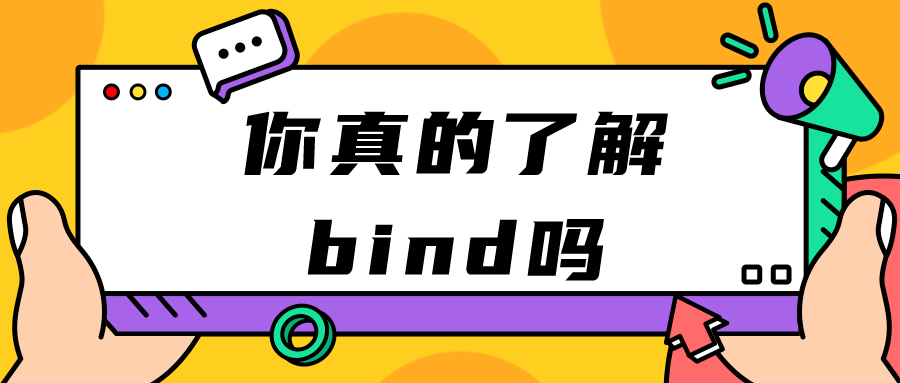
引言
内容速递
看了本文您能了解到的知识!
在本篇文章中,将带你了解什么是bind,bind的用途、如何手写bind以及工作中实际使用bind的场景。
在JavaScript中,bind()方法是用来创建一个新函数,并将其绑定到指定的对象上,从而在调用该函数时确保函数中的this关键字指向绑定的对象。
1、什么是bind
bind()方法创建一个新的函数,在bind()被调用时,这个新函数的this被指定 bind()的第一个参数,而其余参数将作为新函数的参数,供调用时使用。
2、bind的语法
语法:
function.bind(thisArg[, arg1[, arg2[, ...]]])
参数:
-
thisArg:被绑定到函数上的对象,即当调用绑定后的函数时,函数中的
this关键字会指向该对象。如果thisArg参数为null或undefined,则this关键字将指向全局对象(在浏览器中通常是window对象)。 -
arg1, arg2, ...:要传递给函数的参数。这些参数将按照顺序传递给函数,并在调用函数时作为函数参数使用。
返回值:
返回一个原函数的拷贝,并拥有指定的this值和初始参数。
3、浅试一下bind
代码:
this.name = 'guizimo'
let obj = {
name: 'zimo',
getName: function() {return this.name}
}
console.log(obj.getName()) // zimo
let newGetName = obj.getName
console.log(newGetName()) // guizimo
let bindGetName = newGetName.bind(obj)
console.log(bindGetName()) // zimo
简述代码:
-
第一次打印
zimo,可以理解为是打印对象内的一个属性,此时的this是指向obj对象。 -
第二次打印
guizimo,因为当前环境是对象外,因为当前执行的函数是newGetName(),因此函数内部的this指向全局对象。 -
通过
bind生成一个新的拷贝函数,当前执行的函数bindGetName()的this指向obj对象。
4、手写bind
这是面试官最喜欢的环节了
思路:
bind()方法返回一个新函数,因此需要定义一个函数来返回新函数。- 在新函数中,需要使用
apply()或call()方法来调用原始函数并传递正确的this值和参数。 - 新函数需要接受一个
thisArg参数来指定要绑定的对象,并可以接受任意数量的其他参数。
代码:
/**
* 手写bind
* @returns {function(): any}
*/
Function.prototype.myBind = function () {
// 处理函数
let args = Array.from(arguments);
let thisArg = args.shift();
// 暂存this
let thisFunc = this;
// 因为需要构造函数,所以不能是匿名函数了
const fBound = function () {
const newArgs = args.concat(Array.from(arguments));
// 判断是否为构造函数
thisArg = this instanceof fBound ? this : thisArg;
return thisFunc.apply(thisArg, newArgs);
}
// 直接将原函数的prototype赋值给绑定函数
fBound.prototype = this.prototype;
// 返回
return fBound;
}
简述代码:
- 通过
Array.from()将arguments转化为数组对象,通过shift()取出thisArg。 - 使用
thisFunc暂存当前函数的this。 - 创建一个闭包函数
fBound,newArgs接收合并处理的arguments。 - 判断
fBound是否为构造函数,如果是构造函数,返回闭包的this,反之,返回外部拿到的thisArg,使用thisArg来接收。 - 使用
thisFunc.apply传递thisArg值和参数newArgs。 - 直接将原函数的
prototype赋值给fBound。 - 返回
fBound。
5、使用场景
5.1、创建绑定函数
这是bind最基本的一种使用方式了,也就是创建一个新的函数。
代码:
this.name = 'guizimo'
let obj = {
name: 'zimo',
getName: function() {return this.name}
}
console.log(obj.getName()) // zimo
let newGetName = obj.getName
console.log(newGetName()) // guizimo
let bindGetName = newGetName.bind(obj)
console.log(bindGetName()) // zimo
简述代码:
- 第一次打印
zimo,可以理解为是打印对象内的一个属性,此时的this是指向obj对象。 - 第二次打印
guizimo,因为当前环境是对象外,因为当前执行的函数是newGetName(),因此函数内部的this指向全局对象。 - 通过
bind生成一个新的拷贝函数,当前执行的函数bindGetName()的this指向obj对象。
5.2、创建偏函数
如果需要创建一个自定义函数,需要固定部分参数,那么bind就有它独特的作用了
代码:
function add (a, b) {
return a + b
}
const res1 = add(1, 2)
console.log(res1) // 3
// 创建一个偏函数,将1作为预设的参数
const addP = add.bind(null, 1)
const res2 = addP(2)
console.log(res2) // 3
const res3 = addP(3)
console.log(res3) // 4
const res4 = addP(4)
console.log(res4) // 5
简述代码:
- 创建了一个
add函数,调用add(1, 2),正常打印3。 - 创建一个偏函数
addP,将1作为预设的参数,调用addP(2),也可以正常打印3,后续调用addP(3)、addp(4),皆打印正确的数值,实现了对一个参数的固定。
6、在工作中有遇到bind的使用场景吗
6.1、React中bind的场景
在JSX中传递的事件不是一个字符串,而是一个函数(如:onClick={this.handleClick}),此时onClick即是中间变量,所以处理函数中的this指向会丢失。
代码:
<button onClick={this.handleClick.bind(this)}>点击</button>
//此时this指向是当前实例对象
handleAdd = () => {
console.log(this)
this.setState({
...
})
}
解决这个问题就是给调用函数时bind(this),从而使得无论事件处理函数如何传递,this指向都是当前实例化对象。或者使用箭头函数声明一个函数,这样函数内的this也是指向当前实例。
6.2、在事件处理程序中访问事件目标的this值
在JavaScript中,需要在事件处理程序中访问事件目标的this值。在这种情况下,可以使用bind()方法将事件处理程序绑定到事件目标上,以便在调用事件处理程序时,this关键字始终指向事件目标。
代码:
const button = document.querySelector('#myButton');
button.addEventListener('click', function() {
// 在这里可以使用 this 访问按钮元素的属性和方法
}.bind(button));
博客说明与致谢
标签:obj,函数,bind,JavaScript,熟悉,thisArg,console,log From: https://www.cnblogs.com/guizimo/p/17554145.html文章所涉及的部分资料来自互联网整理,其中包含自己个人的总结和看法,分享的目的在于共建社区和巩固自己。
引用的资料如有侵权,请联系本人删除!
感谢勤劳的自己,个人博客,GitHub,公众号【归子莫】,小程序【子莫说】
如果你感觉对你有帮助的话,不妨给我点赞鼓励一下,好文记得收藏哟!
幸好我在,感谢你来!